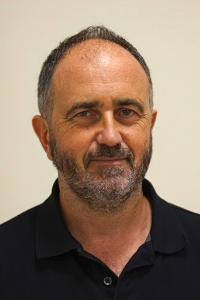 Tsironis Georgios Panagiotis
Tsironis Georgios Panagiotis PhD, leading researcher of the Superconducting Metamaterials Laboratory, director of the Institute of Theoretical and Computational Physics of the University of Crete
Research Interests
Theoretical and computational condensed matter physics, quantum metamaterials, biological and medical physics, artificial intelligence and machine learning.
Field of knowledge according to the OECD classifier
Physical sciences
2020 — present: director of the Institute of Theoretical and Computational Physics of the University of Crete.
Autumn semesters of
Spring semester of 2018: visiting scientist, Cavendish Laboratory, Cambridge University, UK.
2013 — present: coordinator and director, Center for Quantum Complexity and Nanotechnology, University of Crete.
2000 — present: professor, Department of Physics, University of Crete.
1986: PhD, University of Rochester, USA.
1983: master’s degree, physics, University of Rochester, USA.
1981: diploma, physics, University of Athens, Greece.
The focus of research work has been in complex dynamical systems and their applications in quantum metamaterials. The methods are theoretical and computational. The researchers introduced the idea of self-induced transparency in quantum metamaterials, found new nonlinear systems where Parity-Time symmetry plays an important role, introduced and investigated systems with flat bands and focused on the role of dynamical chimeras in superconducting metamaterials. The scientists published, among others, a review article in Physics Report on superconducting metamaterials. In
Scopus Hirsch Index — 36.
Number of articles on Scopus — 194.
ResearcherID: C-2683-2011.
Non-hermitian quantum wave engineering (NHQWAVE), supervisor, RISE Horizon 2020 grant jointly with the Technical University of Vienna and Technion in the EU and Harvard, Yale, Penn State, Washington and Central Florida universities in the US, EUR 600,000,
Nonlinear dynamics, complexity and self-organization in physics and technology, supervisor, NUST MISIS (as part of the Ministry of Education and Science of the Russian Federation program), EUR 550,000,
“Crete Center for Quantum Complexity and Nanotechnology” (CCQCN), supervisor, REGPOT grant, EUR 5 million,
Quantum and superconducting metamaterials, supervisor, Ministry of Education and Science of Kazakhstan, EUR 180,000,
- G. D. Barmparis and G. P. Tsironis, Estimating the infection horizon of COVID-19 in eight countries with a data- driven approach, Chaos, Solitons and Fractals 135, 109842 (2020).
- G. Neofotistos, M. Mattheakis, G. D. Barmparis, J. Hizanidis, G. P. Tsironis and E. Kaxiras, Machine learning with observers predicts complex spatiotemporal behavior, Front. Phys. 7 ,24, (2019).
- N. Lazarides nd G. P. Tsironis, Superconducting metamaterials, Phys. Rep. 752, 1 (2018).
- Z. Ivic, N. Lazarides, and G. P. Tsironis, “Qubit lattice coherence induced by electromagnetic pulses in supercon- ducting metamaterials”, Scientific Reports 6, 29374; doi: 10.1038/srep29374 (2016).
- N. Lazarides, G. Neofotistos, and G. P. Tsironis, “Chimeras in SQUID Metamaterials”, Physical Review B 91, 054303 (2015)
- Gain driven PT-symmetric breathers in nonlinear metamaterials, N. Lazarides and G. P. Tsironis, Phys. Rev. Lett. 110, 053901 (2013).
- “rf SQUID metamaterials, N. Lazarides and G. P. Tsironis, Appl. Phys. Lett.90, 163501 (2007).
- “Discrete breathers in nonlinear magnetic metamaterials”, N. Lazarides, M. Eleftheriou and G. P. Tsironis, Phys. Rev. Lett. 97, 157406 (2006).
- “Targeted Energy Transfer through Discrete Breathers in Nonlinear Systems”, G. Kopidakis, S. Aubry and G. P. Tsironis, Phys. Rev. Lett 87 165501 (2001).
- “Impurity-induced stabilization of solitons in arrays of parametrically driven nonlinear oscillators”, N. V. Alexeeva, I. V. Barashenkov and G. P. Tsironis, Phys. Rev. Lett. 84, 3053 (2000).
Supervised more than 30 undergraduate and postgraduate students.
Teaching
1991 — present: undergraduate and graduate courses in physics, mathematics, programming and machine learning in 5 universities.